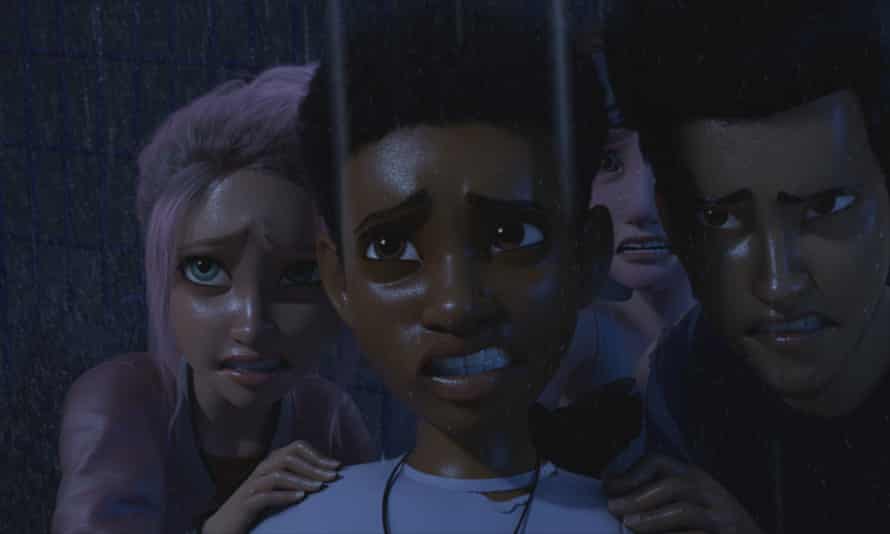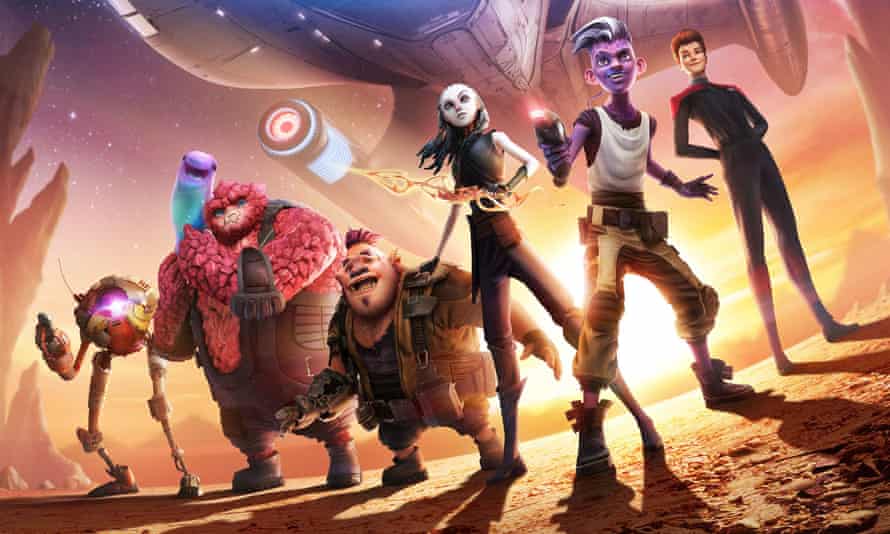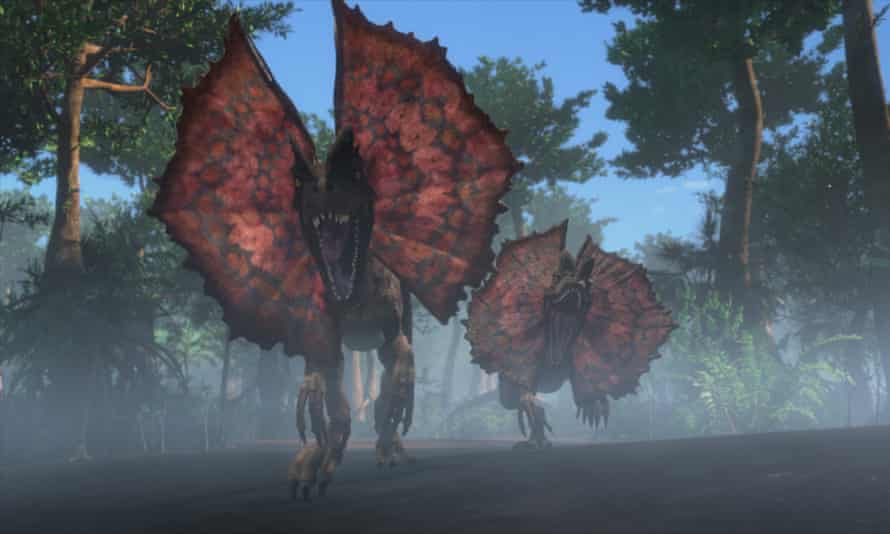‘Children are not allowed on the bridge!” said Captain Picard in Star Trek: The Next Generation’s pilot episode. Nowadays, that attitude has softened, with Trek about to get its own animated series as an antidote to the smörgåsbord of F-bombs, Klingon boobs and decapitated Romulans that populate its live-action incarnations. Alongside Netflix’s Camp Cretaceous – which turns the Jurassic World franchise into a family-friendly cartoon – it’s part of a trend for creating versions of sci-fi shows for children that haven’t lost their power to shock – but won’t give kids nightmares.
It’s a move that raises all sorts of questions. How scary is too scary? Who is allowed to die? And how do you stay true to the essence of a long-running franchise for grownups while reimagining it for a far younger audience?
For the creators of Star Trek: Prodigy, the latter question was easy to address. They introduced a holographic version of one of Trek’s most popular characters – Voyager captain Kathryn Janeway – to help guide the group of alien kids who find themselves commanding an experimental Federation starship. For Prodigy’s writers, she was the perfect choice for a show catering to children.
“She was our first female captain,” says Shawna Benson, who works on the show with her sister, Julie, “and she has a kind of Mama Grizzly protectiveness to her, especially with these kids.”
Actor Kate Mulgrew, however, took a little more convincing. “I hesitated at first,” she tells me at Prodigy’s UK premiere in London. “Because Janeway was very significant to me. I thought, is this reductive? But then a lot of people said to me: ‘Are you crazy? Children will adore this, and their mothers will share it with them.’ So I called them back and said I’d love to do it.”
For Mulgrew, reprising her steely captain for a young crowd means modulating her vocal performance. “I bring a sense of delight to my voice,” she says. “While the fear is real, I don’t want to scare them. I want them to understand we’re in a difficult situation, but we’re going to get out of it. Because if you go too far, children will back up.”
When the creators of Camp Cretaceous were developing a kid-friendly version of the Jurassic World movies, they decided to do it by asking existential questions. “We asked ourselves, what is the DNA of the Jurassic franchise? Why do people watch these films?” says Zack Stentz, creator of Camp Cretaceous. “We decided you need those scary action beats, but you also need Spielbergian moments of awe and wonder.”
Getting those scary moments right is a tricky balancing act when it comes to writing for kids. It can’t be too scary, but you also can’t go too far the other way – particularly if you’re being given input by the creator of Jurassic Park. “Everything to do with the Jurassic franchise goes to Steven Spielberg,” he says. “He’s shot down attempts to do animated shows in the past, and he only agreed this time on one condition: ‘Make it scary!’”

For Stentz, this means finding new ways to present the same action we have seen at the cinema. “You keep the scariness but dial down the goriness,” he says. “People are going to get eaten, but not on camera. We play it on the reactions of the others, and you might hear a crunch. It’s very clear not everyone makes it out alive.”
But there must be some red lines? After all, none of the kids end up as lunch.
“So far!” Stentz laughs. I’m at least 90% sure he’s joking.
In any case, children exist in their own, sometimes baffling, moral universe. A fellow parent told me her dino-obsessed five-year-old loves the Jurassic movies. “He doesn’t mind the people getting chomped,” she says. “As long as nothing bad happens to the dinosaurs.”
It’s a view shared by the Camp Cretaceous writers, who take their lead from Jurassic World director Colin Trevorrow. “Colin always emphasises these aren’t monsters, they’re animals,” says Stentz. “In later seasons, the kids go from strict survival to the idea that they have a responsibility to the dinosaurs. We try to include an ecological consciousness, without hitting people over the head with it.”
Prodigy takes a tamer approach. Over the past five decades, Star Trek might have included its fair share of nasty moments (particularly the terrifying alien earwigs from The Wrath of Khan that have lived rent free in my head for 30 years), but for the Benson sisters, working with Nickelodeon meant treading a fine line. “They have a very clear rule-set of what is and isn’t allowed,” says Julie. “It’s hard in a show where you’re in space and if you open a door you’re dead, but they were keen that it felt real without being too scary.”

Rather than scares, morality takes a major role, with Prodigy wearing its sense of right-and-wrong on its sleeve – in finest Trek tradition. “We talked in the writers’ room about what we wanted kids to take out of each episode as a lesson,” says Shawna. “Working as a team, or being honest. They’re pretty basic tenets, but when you drill down you realise kids kind of know this stuff, but they kind of don’t.”
In a move familiar to anyone brought up on classic cartoons such as He-Man and Captain Planet, every Prodigy episode is accompanied by a clip in which Mulgrew discusses its core lesson. “Those were new to us, but I think they’re wonderful,” says Julie. “They are so on the mark in terms of what we felt each episode was about.”
The attempt to turn grown-up sci-fi franchises into kids’ TV series isn’t new. Back in the 1970s, a cheaply animated 24-minute cartoon rather boldly titled Star Trek continued the adventures of the original Enterprise after the live-action show’s cancellation. By the late 1980s, it seemed every movie franchise had its own kid-friendly spin-off, from The Real Ghostbusters and Ewoks to distinctly improbable retoolings of Robocop and Rambo.
But now, with Prodigy, Camp Cretaceous and even a Fast and Furious spin-off, Spy Racers, it seems kid-friendly adaptations are in for a major revival. This time, though, they’re being created by people who were raised on the originals.
“We were total Trek nerds growing up,” says Shawna. “I had all the episodes taped on VHS, time-stamped with the name of each episode. If you gave me a stardate, I could tell you which one it was!”
“We never really had to think about how to write Star Trek for kids,” says Julie. “We just made the show we knew the eight- and 10-year-old us would have wanted.” And now, children are not just allowed on the bridge – they’re commanding it.
Star Trek: Prodigy is on Nickelodeon now. Camp Cretaceous seasons 1-4 are on Netflix.

